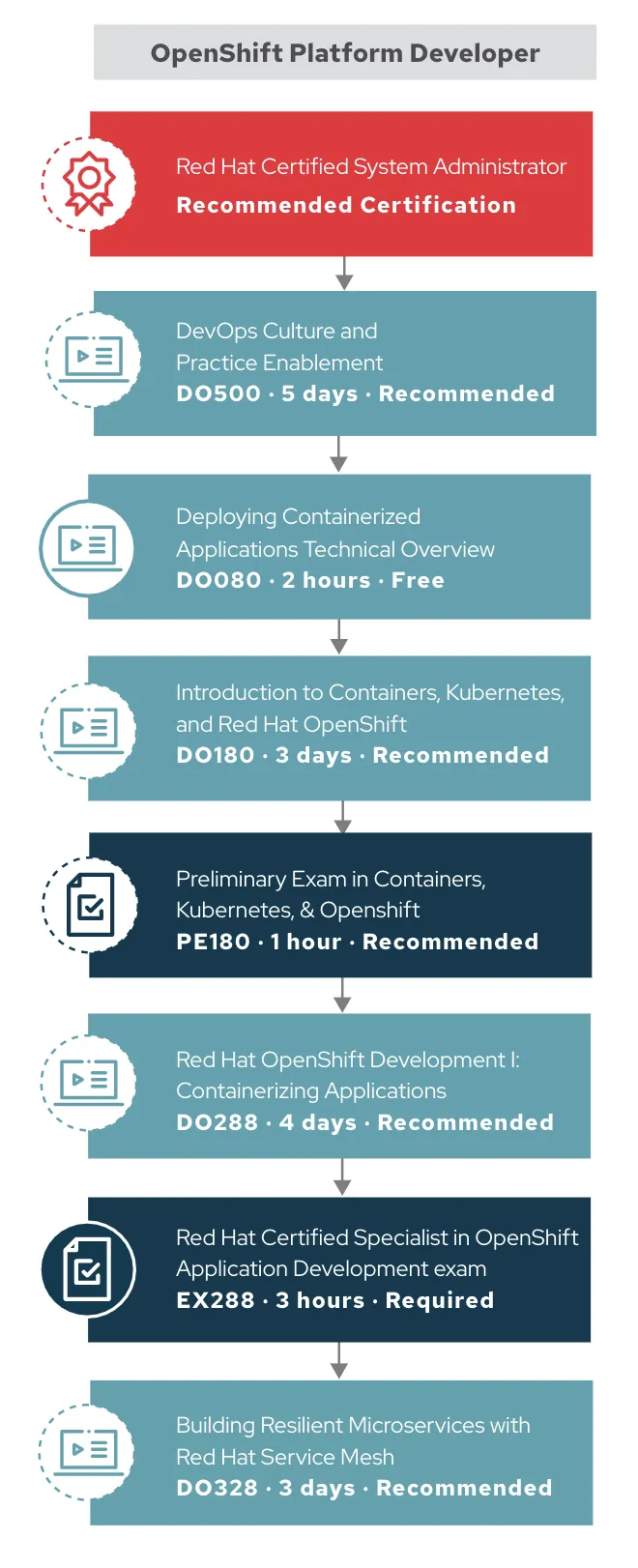When I started as a Red Hat consultant a few years ago, I had limited prior knowledge of containers. I was excited to learn about Red Hat OpenShift Container Platform but also intimidated by all its functionality. The Red Hat OpenShift Platform Developer learning path was very helpful in my journey, and this post will outline some of these resources to help you get started.
While we’re going to focus on the Red Hat OpenShift Platform Developer learning path, you should know that there are two major Red Hat OpenShift learning paths. Both paths are relevant for delivery teams, consultants, and solution architects.
-
Red Hat OpenShift Administrator: This path teaches how to configure, troubleshoot, and manage the Red Hat OpenShift Container Platform.
-
Red Hat OpenShift Platform Developer: This path teaches how to design, build, and deploy containerized software applications on an OpenShift cluster.
The recommended prerequisite for all the courses below is the Red Hat Certified System Administrator (RHCSA) certification. With the exception of DevOps Culture and Practice Enablement (DO500), the following courses are online and self-paced courses.
Note: The courses have been listed in the order in which they should be completed.
1. DevOps Culture and Practice Enablement (DO500): This instructor-led enablement provides an immersive experience in DevOps culture, modern software development practices, and modern application development architectures. Through teamwork, you explore foundational DevOps principles and complete hands-on labs that deploy containerized applications with Red Hat OpenShift Container Platform. This course is based on the Red Hat OpenShift Container Platform, Red Hat Ansible Engine, and Red Hat Enterprise Linux (RHEL).
2. Introduction to Openshift Applications (DO101): This course introduces you to the Red Hat OpenShift Container Platform. It will demonstrate the basic skills required to deploy, update, scale, and troubleshoot applications on OpenShift. It will also demonstrate a good understanding of the benefits of using OpenShift and how to contribute to applications that are deployed on OpenShift.
3. Introduction to Containers, Kubernetes, and Red Hat Openshift (DO180): This course introduces you to container technology and gives an overview of Kubernetes and Openshift. It will also demonstrate how to manage containers and container images. It gives hands-on experience in deploying containerized applications on OpenShift along with troubleshooting them.
4. Preliminary Exam in Containers, Kubernetes, and Openshift (EX180):
The Red Hat Certified Specialist in Containers and Kubernetes exam (EX180) based on the course DO180. This exam tests your skills and knowledge of the fundamentals of containers and Red Hat OpenShift, including the ability to find, customize, run, and manage containerized services in both stand-alone environments, and environments with both Kubernetes and Red Hat OpenShift.
5. Red Hat Openshift Development I: Containerizing Applications (DO288): This course demonstrates how to design, build, and deploy containerized software applications on a Red Hat OpenShift cluster. Whether writing native container applications or migrating existing applications, this course provides hands-on training to enhance developer productivity using the Red Hat OpenShift Container Platform.
6. Red Hat Certified Specialist in Openshift Application Development Exam (EX288): EX288 is a certification based on the DO288. It is an intensive three-hour long exam. Thie exam tests your ability to deploy existing applications in a Red Hat OpenShift Container Platform environment.
7. Building Resilient Microservices with Istio and Red Hat Openshift (DO328): This is a hands-on, lab-based course that teaches how to install, configure, and manage Red Hat OpenShift Service Mesh. This course demonstrates service monitoring, service management, distributed tracing, load balancing, and service resilience.

As a consultant, this path provided me the hands-on experience to design, build, and deploy containerized software applications to an OpenShift cluster. Whether you’re writing container-native applications or migrating existing brownfield applications, this path will help you to learn how to boost developer productivity powered by Red Hat OpenShift Container Platform.
Sull'autore
Prakhar Sethi is a Red Hat consultant based in Los Angeles. He's a Red Hat Certified Architect in Infrastructure II, and also has experience with Red Hat OpenShift, Ansible Automation, full stack development and Red Hat Process Automation Manager.
Altri risultati simili a questo
Red Hat and Sylva unify the future for telco cloud
Bridging the gap: Secure virtual and container workloads with Red Hat OpenShift and Palo Alto Networks
Get into GitOps | Technically Speaking
Air-gapped Networks | Compiler
Ricerca per canale
Automazione
Novità sull'automazione IT di tecnologie, team e ambienti
Intelligenza artificiale
Aggiornamenti sulle piattaforme che consentono alle aziende di eseguire carichi di lavoro IA ovunque
Hybrid cloud open source
Scopri come affrontare il futuro in modo più agile grazie al cloud ibrido
Sicurezza
Le ultime novità sulle nostre soluzioni per ridurre i rischi nelle tecnologie e negli ambienti
Edge computing
Aggiornamenti sulle piattaforme che semplificano l'operatività edge
Infrastruttura
Le ultime novità sulla piattaforma Linux aziendale leader a livello mondiale
Applicazioni
Approfondimenti sulle nostre soluzioni alle sfide applicative più difficili
Virtualizzazione
Il futuro della virtualizzazione negli ambienti aziendali per i carichi di lavoro on premise o nel cloud